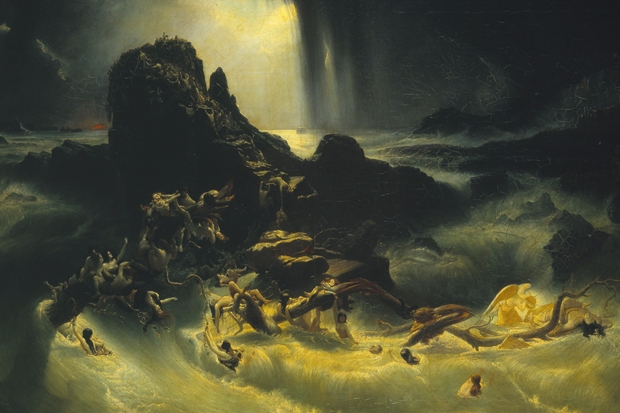One of the more exotic attractions at the 1939–40 World’s Fair in New York was Salvador Dalí’s ‘Dream of Venus Pavilion’, which behind its surreal façade — an architectural marriage between Antoni Gaudí and a coral reef — catered to the public’s aquatic fantasies of spume-born goddesses and topless sirens.
Something similar is going on behind the cool modernist exterior of Tate St Ives. Aquatopia: The Imaginary of the Ocean Deep is a bottom-trawler of an exhibition that dredges the depths of the human psyche for fishy fantasies. As the show’s catalogue points out, earth’s deepest oceans — the murky regions known, in descending order, as bathypelagic, abyssopelagic and hadal — are nine-tenths unexplored, a figure that happens to coincide with the proportion of the human psyche allocated by Freudians to the unconscious. What we don’t know, our unconscious dreams up. In the words of John Steinbeck: ‘An ocean without unnamed monsters would be like sleep without dreams.’
Human imagination being a somewhat limited faculty, our unnamed monsters tend to rest on recognisably fishy foundations: those in Turner’s ‘Sunrise with Sea Monsters’ (1845), for example, are just pumped-up versions of the gurnard in a nearby sketch. But to landlubbers’ eyes the denizens of the deep are quite fantastic enough without embellishment, and many species in Aquatopia are represented faithfully. Whales figure largely in paintings by Alfred Wallis and Henry Scott Tuke, among others, and in scrimshaws by anonymous whalers; stencils of dolphins by Steven Claydon cover the walls, making the galleries look like palatial bathrooms; life-sized sharks in mixed media (no formaldehyde) by Ashley Bickerton and Dorothy Cross hang from the ceiling; and a ‘Sturgeon’ in a glass case by Mark Dion rests on a bed of costume jewellery recalling Shakespeare’s ‘heaps of pearl, inestimable stones, unvalued jewels’. Lower down the food chain, a colony of baby zebra mussels clings to a model of a Henry Moore sculpture submerged by Simon Starling into Lake Ontario, and wooden barnacles bloom in the eye sockets of a limewood skull carved by Ricky Swallow. More fantastic, because based in reality, is the selection of models of marine invertebrates wondrously spun in glass by the Blaschka family.
But the dominant species in this show, if you’re counting appearances, is the cephalopod. ‘A glutinous mass, endowed with a malignant will, what can be more horrible?’ is how Victor Hugo characterised this aquatic villain of countless sci-fi novels and horror films. But in the works in this exhibition, the cephalopod comes across more as a sexy beast than as a kraken. Its eroticisation dates back to Hokusai and his 1814 woodblock illustration ‘Pearl Diver and Two Octopi’, a three-on-the-sea-bed romp leaving little to the visual imagination — and spelling that little out in the accompanying text, which has been helpfully translated into English: ‘Inside, squiggle, squiggle, ooh, good… There, there! Theeeeere! … Whew! Aah! Good, good, aaaaaaaaah! Not yet…’ Meg Ryan’s performance in When Harry Met Sally seems tame by comparison.
Hokusai spawned a genre of tentacle porn to which ‘Sex is Good’ (1999), a knitted octopus by Vidya Gastaldon & Jean-Michel Wicker, and ‘Hokusai’s Octopai’ (2004), a stuffed latex version by Spartacus Chetwynd, belong. Chetwynd’s octopus also dances to a heavy-metal soundtrack in an accompanying video, ‘Erotics and Beastiality’. Video soundtracks are the bane of exhibitions, but all the videos here come equipped with headphones apart from the Otolith Group’s ‘Hydra Decapitata’, which is overloud and, at 31 minutes, overlong. The best artists’ videos, in my experience, are short and funny. Two good examples in this show are Shimabuku’s ‘Then, I decided to give a tour of Tokyo to the octopus from Akashi’ (2000) — an amusing experiment in tentacle tourism — and Alex Bag and Ethan Kramer’s ‘Le Cruel et Curieux Vie du la Salmonellapod’ [sic] (2000), a spoof nature film about a ‘sadistic, masochistic, sexually enthusiastic’ amphibious mammal performed by puppets: The Magic Roundabout meets Jacques
Cousteau.
For lovers of more traditional media there are paintings by Turner, Stanhope Forbes, Francis Danby, Lucian Freud and Karl Weschke. William Lionel Wyllie offers a rare glimpse into ‘Davy Jones’s Locker’ (1889) and Eric Ravilious a poignant view inside a ‘Submerged Submarine’ (c.1940), two years before he himself tragically sank to a watery grave.
Other haunting images include Odilon Redon’s shadowy visions of the hadal regions and Gustave Doré’s brilliantly spooky illustrations of ‘The Rime of the Ancient Mariner’, recently plundered by the designers of Pirates of the Caribbean. Nothing much changes in the depths of the human unconscious. The hippocamp armed with the monster-skull glove puppet in Mantegna’s ‘Battle of the Sea Gods’ (c.1475/88) could belong in a modern video game, as could the warrior and fishy monsters ‘Retrieving the Treasure Ball’ in Utagawa Kuniyoshi’s woodblock print.
This is a marvellous show, in the old-fashioned sense. My only quibble, with which Dalí would agree, is that there are too few mermaids. Any catalogue that mentions ‘gender politics’ in its opening paragraph is, I suppose, bound to tiptoe around this subject, but Juergen Teller’s photo of Bjork spewing spaghetti nero out of her mouth like seaweed is no dream of Venus, and the only other siren on offer — Liz Craft’s rather touching ‘Old Maid’ (2004) — is of pensionable age.






Comments